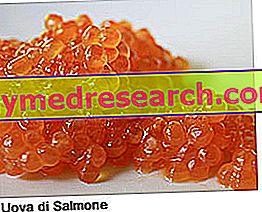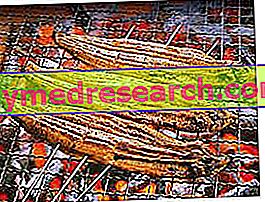Generality
Fish eggs are the female gametes of fish species, "usually" destined for fertilization by the male, therefore deputies to the reproduction of the species.
From the food point of view, fish eggs are not only a potential nutritional resource, but often represent a delicious and very expensive food. In the collective imagination, fish eggs are synonymous with caviar, an elite food generally used in conjunction with special events ... or more frequently MA for decidedly more "wealthy" social classes than the popular average. However, fish eggs (despite the etymology of the term) constitute a group of products derived from aquatic organisms that are not necessarily saltwater fish; the objective of the article is to provide a somewhat broader view of the meaning "fish eggs" and to briefly illustrate its origin and fundamental nutritional characteristics.
Fish eggs, but not only ...
The fish eggs therefore include the female gametes of the sea fish proper, of the fresh water fish proper, of the crustaceans (usually of sea) and of the Echinoidea or, more commonly, sea urchin (exclusively of sea). Let's look at them in more detail:
Mixed water fish eggs
Caviar
Sturgeon fish eggs (shark that lives in the sea but goes back to the rivers to lay) are a delicacy whose production "moves" several billion euros a year; the country that produces the largest quantity is Russia (which fishes for sturgeon), followed by France, Spain, etc. (which instead raise it).

Salmon roe
even salmon roe is a fairly widespread production.

Salt water fish eggs
Lompo eggs
In the food sector, lumpfish eggs are the most popular fish eggs after caviar, compared to which, however, they have exceeded production and average annual consumption. The lump ( Cyclopterus lumpus ) is a salt water fish of the northern seas that produces eggs aesthetically very similar to caviar but with a decidedly less characteristic taste; for this reason, lompo fish eggs have reached a decidedly wider market than sturgeon fish eggs, with respect to which they constitute the most known and economic substitute. Lompo fish eggs are also a progenitor of Danish cuisine, in which they are cooked and accompanied with preparations of other fishery products.
Herring eggs
Also herring fish eggs ( Sardina pilchardus ) are a very common food in Japan; they are yellow or red and are enclosed in the placenta in a single strand.
Cod eggs
Once again there is a large consumption of fish eggs in Japanese cuisine; they result (like those of herring) joined in the placenta and are cooked on the plate or on the grill. In Sweden they form a spreadable smoked and smoked pasta, generally accompanied with bread.
Flying Fish Eggs:
They are grainy, of different colors and with a crunchy texture. Less stronger than the others, I am used frequently in the accompaniment and decoration of sushi.
Red mullet eggs
Mullet fish eggs are a Japanese exclusive, from the city of Nagasaky, of which no other variants are known.
Tuna eggs, swordfish and mullet-mullet
Mullet-mullet fish eggs, swordfish and tuna are an Italian specialty; they are yellow or orange and are kept inside the placenta, then salted and smoked. At the end of the processing, we obtain very intense flavor cakes called bottarga, used differently according to the species, but all delicious if grated or served in small pieces on first courses of fish. As far as mullet-mullet fish bottarga is concerned, it takes place after fishing ... and the disposal of dead fish is not always "very clear"; also in this case it is a barbaric and not eco-sustainable practice (often used by poachers), while the collection of tuna fish eggs (or any other fish with eggs on its lap: ricciola, cerna etc.) is occasional and secondary to the trade of their meat. From all fish species it is possible to obtain bottarga.
In many other countries of the world fish-based preparations are consumed, less known than those described above and whose consumption is limited to the place of production.
Fresh water fish eggs
Carp eggs
The carp fish eggs are yellow and of medium size, they are united in the placenta or shelled depending on the level of ripeness; they are widely consumed in Greece, where they are called tarama and are processed to be eaten as an accompanying sauce. On the other hand, although they are less documented, there are many other places in which they are used; in addition to all the Eastern European countries, which also use the fish itself as a food source (custom lost in Western Europe), also in Italy (in particular in the Po Valley), until a few decades ago, the eggs of carp or tinca or carassio were used (together with soft wheat flour and chicken egg) to make a tasty dough fried in lard or olive oil.
In all the countries of the hinterland, which do not overlook the sea or where food resources are scarce, freshwater fish eggs represent a more unique than rare nutritional source; some examples are Indo-Asian countries such as the Philippines, Thailand, India, Bangladesh ( Labeo rohita eggs) etc.
Sea invertebrate eggs
Sea urchin eggs
Sea urchin eggs are a food extracted from the Echinoidea, an invertebrate. They appear yellow-orange or tending to red and are enclosed in some small placentas distributed as if they were "petals of a flower" inside the invertebrate; the eggs are picked by breaking the animal and extracting them in the RIGHT lunar period, or when the hedgehog is full but has not yet laid them. Sea urchin eggs are a fairly widespread food, extremely valuable and whose collection is strictly regulated by the authorities of various countries; they are eaten raw in the first Italian dishes and similarly, or half-cooked, in other Chilean, Korean and (again ...) Japanese preparations.
Fish eggs - Nutritional values »



